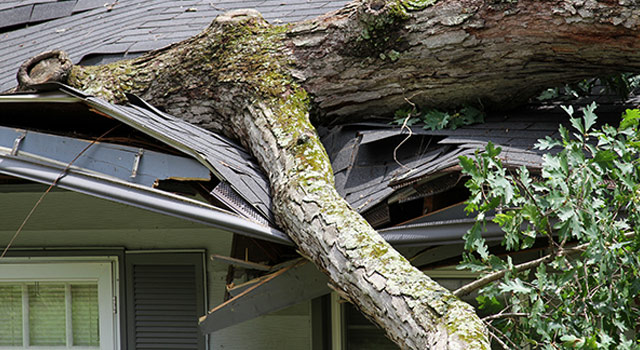Trees are beautiful, but they can also be dangerous. If a tree falls on your property, one of your first thoughts might be, “Does homeowners insurance cover tree damage?” The answer is maybe. It all depends on what caused the tree to fall and where it lands. Let’s explore the details.
When does your home insurance cover tree damage
In most cases—but not all—damage caused by trees will be covered by your homeowners insurance policy. Here’s a quick breakdown of how your policy is set up to cover tree damage:
| Dwelling (Coverage A) |
| Covers tree damage to your home due to any event, except for exclusions. An exclusion is an event that is specifically listed in your homeowners policy. |
| Other Structures (Coverage B) |
| Covers tree damage to other structures on your property due to any event, except for exclusions. Other structures include fences, sheds and detached garages. |
| Personal Property (Coverage C) |
| Only covers tree damage to your possessions due to named perils. A named peril is a cause that is specifically listed in your policy. Examples include wind, lightning and vehicles. |
Let’s say a powerful storm blows through your neighborhood, uprooting a giant elm tree. Because wind is not specifically listed as an exclusion on your homeowners policy, your insurance would cover damage to the following:
- Your home’s structure, including the roof
- Other structures on your property, such as a fence, shed or detached garage
- Your driveway
Remember, you can always talk to your insurance carrier to learn more.
Who Determines the Cause
After you submit the claim, an insurance adjuster will carefully examine the facts of the loss as well as your homeowners insurance policy. Based on their investigation of the fallen tree, they can determine if you’re covered or not.
When does your home insurance not cover tree damage
Homeowners insurance is primarily designed to address events that you can’t predict or prevent, like fires, high winds and heavy snow. Sometimes, though, trees or limbs fall due to preventable causes, like rot or broken roots. In these cases, your homeowners insurance may not offer coverage.
Here are some other scenarios when a standard homeowners insurance policy may not cover damage caused by a falling tree or limb.
- Yard damage – If a fallen tree damages your lawn, most insurance carriers won’t pay for landscapers to restore the lawn to its original condition.
- Tree removal – Most home insurance policies won’t cover tree removal alone. Usually, the tree must also damage your property in order for your insurance to cover tree removal.
Another interesting coverage situation deals with damage to the tree itself. For example, if your beloved Japanese red maple is damaged by decay, your insurance policy won’t replace it. But if it’s hit by lightning, your policy would cover the damage.
This chart details which causes are typically covered by your policy:
| Cause of Damage to Tree/Shrub/Plant | Covered by Home Policy | Not Covered by Home Policy |
| Theft | X | |
| Rot/decay | X | |
| Explosion | X | |
| Old age | X | |
| Fire or lightning | X | |
| Vandalism | X | |
| Vehicle (not owned or operated by resident) | X |
More Coverage Questions
Here are some other insurance coverage questions you may be curious about:
The person whose property was damaged is responsible for filing the insurance claim, no matter who owns the fallen tree. Therefore, if your neighbor’s tree (or any part of the tree) lands on your house, you would have to file the claim with your homeowners insurance carrier—not your neighbor.
If your neighbor’s tree fell due to a covered risk, your insurance carrier would pay to repair the damage it caused to your property.
No, it won’t. In this case, your auto insurance would pay to repair the damage to your car.
Unfortunately, no. Your property must be damaged by a fallen tree or limb for home insurance to apply. Remember, maintaining healthy trees is part of your job as a homeowner—the same way you’re expected to keep your pipes warm in the winter.
If a fallen tree blocks an access point on your property, your homeowners insurance policy may cover the cost of tree removal. Examples of access points include your home’s front door, your driveway, your garage or a handicap ramp. Consult with your home insurance carrier to be sure.
How to prevent tree damage
The best defense against tree damage is to prevent it from happening in the first place. And the best way to do that is to regularly inspect the trees around your property.
Regular Inspections
You can either schedule an inspection with an arborist or inspect the trees yourself. An arborist will cost you, of course, but they can identify the less obvious signs of trouble and recommend next steps.
If you choose the DIY route, here are the tree hazards that you should look for:
Preparing for Storms
Strong storms can cause even the healthiest of trees and limbs to fall. And while you can’t prevent the wind from blowing or lightning from striking, you can mitigate potential damage to your property. Here are some steps you can take:
- Remove diseased trees
- Prune dead branches
- Prune healthy branches overhanging your home
- Reduce number of branches in the tree’s canopy to allow wind to flow
- Stake young trees to ground
